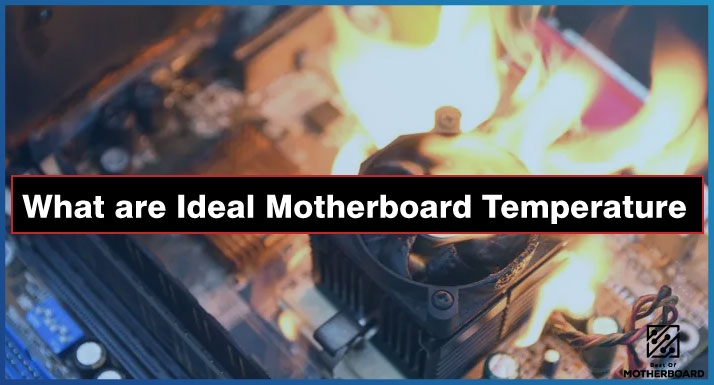A temperature range of 30-80 degrees Celsius (86-176 degrees Fahrenheit) is considered safe and appropriate. When performing demanding tasks, such as gaming, any temperature below 80 C is acceptable. A normal idle temperature is 31 C.
However, it is important to check the manufacturer’s specifications for the specific model of the motherboard to determine the optimal operating temperature range.
The temperature of your motherboard is quite important in your motherboard’s lifespan. It also goes a long way to determine your motherboard’s stability and performance. If your motherboard starts heating up, your computer becomes unstable. This could cause crashes to your computer. It could also lead to the loss of tangible files.
How Important is the Motherboard Temperature
Your motherboard is the heart of your computer. All the processes necessary for running your computer depend on the motherboard. So, your motherboard must be in a good temperature state for the proper performance of your computer.
The reactions of electrons and semiconductors on the motherboard could cause an increase in electrical conductivity. There is, however, a threshold temperature that this reaction must not go beyond. Maintaining a temperature under the threshold mark will aid the performance of your computer. This will also prevent damage to components.
So, stay glued as we educate you on the safe temperature for your motherboard. We will also show you how you can keep your computer from overheating.
Safe Gaming Temperature for Your Motherboard
The safe gaming temperature for your motherboard is 80°C. So, you must ensure that your components maintain a temperature within this range. You are at risk if your motherboard or CPU’s temperature exceeds this figure. You risk damaging some components of your computer.
When your computer is idle, the temperature of your motherboard should be between 20 and 80°C. The temperature of your motherboard is unlikely to remain at 20°C when your computer is active. Although, if you have a very cold environment, this is a possibility.
During regular use, your computer should maintain a temperature range of within 50°C. The average temperature of your CPU might be higher. This is because the CPU comes with a dedicated heatsink. It is necessary to maintain temperatures below 80°C.
Related: Do You Need to Reinstall Windows After Replacing CPU
Motherboard Temperature Over 100?
A motherboard temperature of more than 100 degrees Celsius (212 degrees Fahrenheit) is considered extremely hot and can be caused by several factors. High motherboard temperatures can be caused by a variety of factors, including:
- Overclocking: Overclocking the CPU or GPU can generate more heat than the motherboard is designed to handle, resulting in high temperatures.
- Insufficient cooling: Heat generated by the CPU and GPU can accumulate if the system is not adequately cooled, causing the motherboard temperature to rise.
- Dust and debris: If the system is not cleaned regularly and the fans and heatsinks become clogged with dust and debris, proper airflow can be disrupted, causing the motherboard temperature to rise.
The first step in resolving a high motherboard temperature is to identify the source of the problem and take appropriate action. If the problem is caused by overclocking, the CPU or GPU clock speeds can be reduced to reduce heat output. If insufficient cooling is the cause of the problem, additional fans or a liquid cooling system can be installed to improve airflow and cooling. If dust and debris are the sources of the problem, the system can be cleaned, and the fans and heatsinks can be checked and cleaned as needed.
Causes Of Motherboard Overheating and Fixes
One major problem that causes overheating is dust. When dust clogs the heatsink of your computer, the computer won’t be able to breathe. The available fresh air will not circulate appropriately. Hence, overheating occurs.
If your computer is placed in a cabinet area or a region that is too dusty, the components inside can overheat. Most computers are air-cooled devices. This means that the air around your computer must be cooler than the air inside for your motherboard to stay cool. You might not have an air conditioner but plenty of fresh air would do.
It, therefore, means that you must make sure that your computer is not in an enclosed area. If not, you are going to experience problems with heat. Not just your motherboard will be affected by the heat issues. Your hard drives, power supply unit, and processor can also be vulnerable to heat.
How to Ensure Your Motherboard’s Temperature Is Within Safe Ranges
Your motherboard sends commands that the major components of your computer run on. These components’ performance depends on how efficiently your motherboard sends the commands.
The more commands your motherboard process, the more electricity flows. This leads to more generation of heat. When this heat becomes too much, your computer’s performance drops. It starts showing signs of failure and damage to your computer.
It is, therefore, necessary that good airflow is maintained for your computer. This will help reduce heat levels.
Let’s consider some of the ways you can cool your computer. This will help maintain a good temperature for your motherboard:
- One good hack you can try is to open your computer case. This will enable you to see the components of your computer. You will be able to verify if they are still working properly.
- A normal computer must come with two fans. One of the fans will be at the front to allow air inflow. The other discharges hot air out. If you notice that the fan is no longer spinning, you must replace it. If the power supply fan is no longer working, you might have to replace the power supply.
- You should also try cleaning the fans of your computer. This will help clear all the debris. Dust can increase friction and reduce the efficiency of the fans.
- You should ward off cleaning the power supply fan. It can be particularly dangerous because of the high amounts of electricity that flows through it. If you notice that it has too much dust, the best thing to do is replace it.
- Sometimes, the best thing to do is get new components for your computer. By simply getting new and efficient components, the heat level will drop. For instance, an old graphics card will produce excess heat. Whereas a contemporary card will produce less heat.
Related: How Many Hard Drives Can My Motherboard Support
Is 75, 80, 85, and 90 Celsius hot for the CPU while gaming?
While gaming, a CPU temperature of 75 degrees Celsius (167 degrees Fahrenheit) is considered high but not necessarily dangerous. However, remember that each CPU and motherboard is unique, and the maximum operating temperature may vary depending on the model and manufacturer.
If the temperature of your CPU exceeds the maximum operating temperature specified by the manufacturer, the CPU may slow down or even shut down to prevent damage.
Conclusion
The motherboard is a very important part of your computer. It determines the performance of your computer to a large extent. Due to its function, there is every tendency for it to get too heated. This, however is not ideal for your computer.
We have shown you the temperature ranges that your motherboard must maintain. So, you must ensure that this temperature is not exceeded. We have also highlighted how you can reduce the temperature.
So, follow our insights and get the best of your motherboard.



![What Are Motherboard Standoffs? [Guide] 4 What Are Motherboard Standoffs](https://bestofmotherboard.com/wp-content/uploads/2022/01/What-Are-Motherboard-Standoffs.jpg)
![Does it Matter Which PCIe x16 slot I Use? [Guide] 5 Does it Matter Which PCIe x16 slot I Use](https://bestofmotherboard.com/wp-content/uploads/2022/01/Does-it-Matter-Which-PCIe-x16-slot-I-Use.jpg)